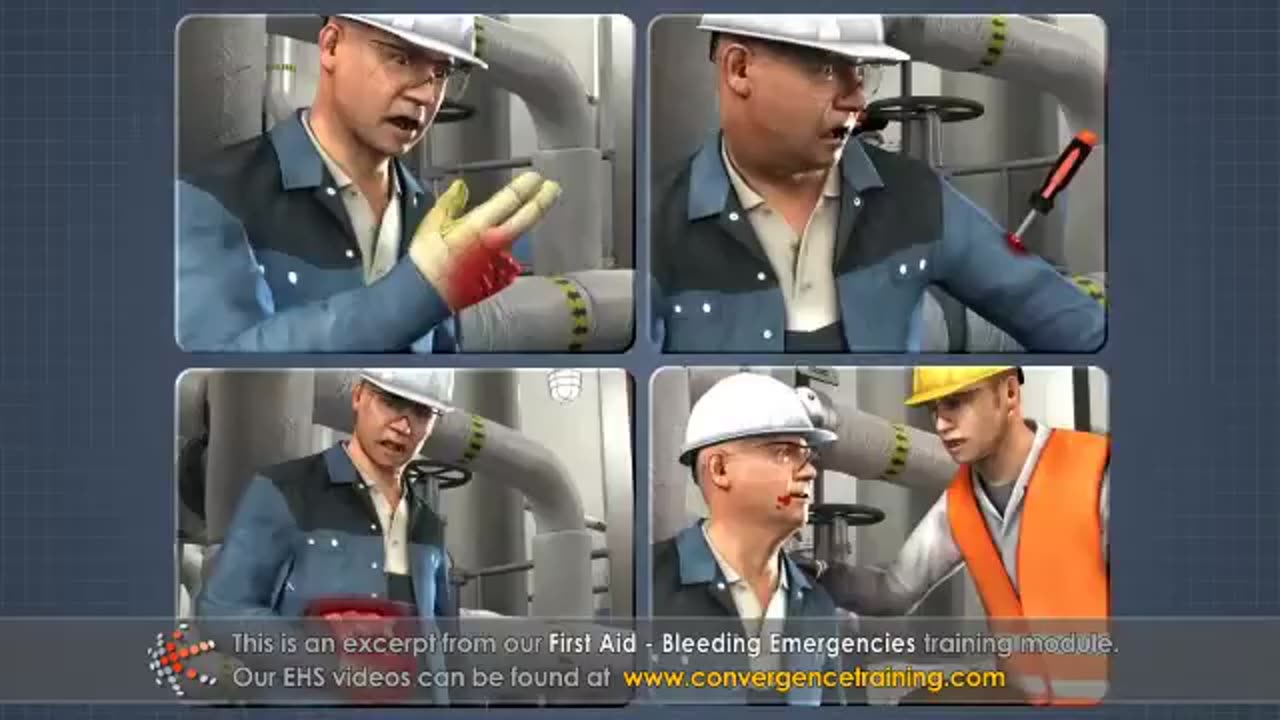Premium Only Content

First Aid - Bleeding Emergencies Training
**First Aid Training for Bleeding Emergencies** is a vital skill to help stabilize a person and prevent life-threatening blood loss. Below is a structured guide to train individuals on recognizing, assessing, and treating various types of bleeding.
---
## **1. Introduction to Bleeding Emergencies**
- **What Is Bleeding?**
- Loss of blood from veins, arteries, or capillaries due to injury.
- Categories:
- **External bleeding**: Blood exits the body through wounds.
- **Internal bleeding**: Blood loss inside the body, not visible.
- **Why Immediate Action Is Crucial?**
- Severe blood loss can lead to shock, organ failure, or death.
- Rapid intervention can stabilize the victim until professional help arrives.
---
## **2. Types of Bleeding**
1. **Arterial Bleeding**:
- Bright red, spurting blood (due to high pressure).
- Most severe and requires urgent care.
2. **Venous Bleeding**:
- Dark red, steady flow of blood.
- Can also be serious but less urgent than arterial bleeding.
3. **Capillary Bleeding**:
- Oozing blood from minor cuts or abrasions.
- Typically not life-threatening.
---
## **3. Recognizing Signs of Severe Blood Loss**
- Pale, cold, or clammy skin.
- Rapid heartbeat and weak pulse.
- Dizziness, confusion, or loss of consciousness.
- Rapid breathing.
- Visible pooling or spurting of blood.
---
## **4. Immediate First Aid Response**
### **A. Stop the Bleeding**
1. **Apply Direct Pressure**:
- Use a sterile cloth, gauze, or the cleanest available material.
- Apply firm pressure directly over the wound.
2. **Elevate the Wounded Area**:
- Raise the injured limb above heart level (if no broken bones are suspected) to reduce blood flow.
3. **Apply a Pressure Bandage**:
- Secure the dressing with a bandage while maintaining pressure.
4. **Use a Tourniquet (for severe arterial bleeding)**:
- Place it 2–3 inches above the wound.
- Tighten until the bleeding stops.
- Record the time it was applied; prolonged use can cause tissue damage.
---
### **B. Treat for Shock**
- Lay the victim flat on their back.
- Cover them with a blanket to maintain body temperature.
- Keep their head slightly lower than the chest to promote blood flow to vital organs.
---
### **C. Do Not:**
- Remove embedded objects. Instead, apply pressure around the object and stabilize it.
- Remove blood-soaked dressings. Add layers of gauze over them.
---
## **5. Specific Scenarios**
1. **Nosebleeds**:
- Sit the person upright, leaning slightly forward.
- Pinch the nostrils for 10–15 minutes.
- Avoid tilting the head backward to prevent swallowing blood.
2. **Head Wounds**:
- Apply pressure around the wound, avoiding pressing directly on fractures.
- Watch for signs of skull fractures (e.g., clear fluid or blood from ears/nose).
3. **Internal Bleeding (Suspected)**:
- Symptoms: Bruising, swelling, or tenderness; signs of shock.
- Keep the victim still and calm.
- Call emergency services immediately.
4. **Amputations**:
- Control bleeding using a tourniquet if necessary.
- Save the severed part in a clean, moist cloth, place it in a sealed plastic bag, and keep it cool (do not freeze).
---
## **6. Personal Safety for the Responder**
- **Use Personal Protective Equipment (PPE)**:
- Wear gloves, if available, to avoid contact with bloodborne pathogens.
- **Avoid Direct Contact**:
- Use a barrier, such as plastic wrap or a clean cloth, if gloves aren’t available.
---
## **7. Calling Emergency Services**
- Provide the following information:
- Location and type of injury.
- Amount of blood loss and condition of the victim.
- Actions taken so far.
---
## **8. Aftercare and Monitoring**
- Check for continued bleeding and signs of infection:
- Redness, swelling, warmth, or pus around the wound.
- Fever or increased pain.
- Ensure the victim gets tetanus shots if necessary.
---
## **9. Training Exercises**
- **Simulated Scenarios**:
- Role-play different bleeding emergencies (e.g., limb injury, nosebleed, amputation).
- Practice applying direct pressure, bandages, and tourniquets.
- **Equipment Familiarization**:
- Practice with first aid kits, including dressings, gauze, and tourniquets.
---
## **10. Summary and Key Points**
- Act quickly to control bleeding.
- Use direct pressure, elevation, and bandages.
- Apply a tourniquet only as a last resort.
- Treat for shock and monitor the victim until professional help arrives.
---
### **Would you like additional visual materials, such as diagrams of proper techniques, or a printable checklist for first responders?**
-
 6:54
6:54
HSESafetyInformation
7 months ago6 Must Try Breakfast recipes By Food Fusion
351 -
![[MnK] Nighttime Duos w/ Spartakus 🔥 6.7 K/D](https://1a-1791.com/video/fww1/59/s8/1/C/e/8/k/Ce8kz.0kob-small-MnK-Nighttime-Duos-w-Sparta.jpg) LIVE
LIVE
GloryJean
2 hours ago[MnK] Nighttime Duos w/ Spartakus 🔥 6.7 K/D
107 watching -
 LIVE
LIVE
CharleyHornsePlays Gaming & Entertainment
1 hour ago🔴CHP GAMING | Diablo 4 Season 10 Sorcerer
36 watching -
 LIVE
LIVE
LFA TV
21 hours agoBREAKING NEWS: SHOOTER IN DALLAS! | WEDNESDAY 9/24/25
856 watching -
 LIVE
LIVE
Charlotte Winslow
3 hours ago⚔ playing Assassin's Creed Brotherhood for the First Time!
55 watching -
 LIVE
LIVE
Spartan
1 hour agoSilent Hill F
17 watching -
 23:42
23:42
AndresRestart
5 hours agoThe Most Peak Nintendo Direct Of 2025 Hasn't Happened Yet!?
3.17K1 -
 7:24:01
7:24:01
Dr Disrespect
9 hours ago🔴LIVE - DR DISRESPECT - WHAT THE HELL IS THIS GAME?
115K16 -
 1:04:22
1:04:22
BonginoReport
4 hours agoICE Agents, Facilities Under Attack - Nightly Scroll w/ Hayley Caronia (Ep.141)
154K84 -
 LIVE
LIVE
Mally_Mouse
7 hours ago📣Telescreen Talks - LIVE!
62 watching